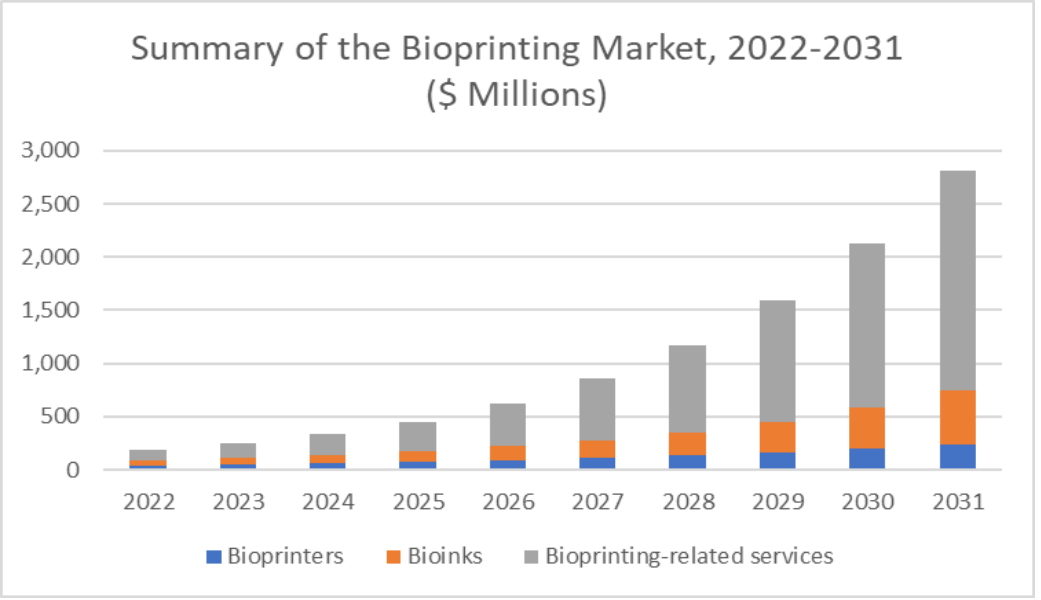After years of monitoring the bioprinting industry, a new SmarTech Analysis report estimates that this segment’s market size is expected to reach almost $1.2 billion in 2028, compared with just $182 million today. In “Bioprinting: Markets and Opportunities,” the AM industry analysis firm expects almost 70 percent of the bioprinting industry to come from applications and service revenues and anticipates that bioprinters will bring in around $100 million in revenues by 2031.
Bioprinting has evolved since the development of the first bioprinter in the early 2000s to the production of pathology models, tissue design for drug screening, medical research, and regenerative medicine. Although the ideal workflow of bioprinting – which ends with the replacement of functional organs in patients – still needs to overcome several challenges, breakthroughs in bioprinting have already led to advances in microfluidics and organs-on-a-chip, with 3D printed biomaterials increasingly becoming part of medical procedures, such as for bone and graft production.
 Cellink’s bioprinters and tissue specific materials help researchers engineer tissue models. Image courtesy of BICO
Cellink’s bioprinters and tissue specific materials help researchers engineer tissue models. Image courtesy of BICOThe report also claims that although we are many years from transplanting printed organs, bioprinting is finding a rapidly growing application in drug and cosmetics testing. Using printed tissues and organs avoids the need for animal testing and enables testing on printed tissue and organs that are realistic substitutes for the real thing. Additionally, production-grade bioprinters and reproducible bioprinting applications are coming to the fore, so by 2031, research and development service revenues will clock up almost $250 million in service and applications revenue for bioprinting, which will still only amount to 12 percent of total service and applications revenues in the bioprinting industry.
“New applications are quickly emerging for bioprinting, and they are very much in line with important megatrends in healthcare—notably the trends towards personalized medicine and bringing care closer to the patient. For example, bioprinting can enable procedures such as skin grafting to be performed in a clinic rather than at specialized hospitals,” said Lawrence Gasman, founder of SmarTech Analysis and author of the report.
 Graph from SmarTech Analysis bioprinting report: “Bioprinting: Markets and Opportunities.” Image courtesy of SmarTech.
Graph from SmarTech Analysis bioprinting report: “Bioprinting: Markets and Opportunities.” Image courtesy of SmarTech.As SmarTech’s third major report on the topic, it highlights the leading trends in the industry and covers everything from bioprinters to bioprinting applications, including soft robotics, pill printing, and printed food, and examines the long-term prospects for transplanting bioprinted organs. It says that bioprinters will move beyond the currently dominant extrusion and inkjet machines, which account for over 90% of bioprinter revenues today. Moreover, the document states that “by 2031, 15 percent of bioprinter revenues will come from printers based on entirely novel printing technologies.”
Through a realistic assessment of bioprinting’s commercial future and a thorough analysis of the companies in the sector, SmarTech determines that technological innovation across the entire bioprinting sector will accelerate. The new report points to three developments in particular as areas of strong commercial potential, for example, organs-on-a-chip. Additionally, it identifies technical trends leading bioprinting forward and will improve patient costs and expand capabilities. One such trend is next-generation bioprinting platforms that have greater capacities, can automate the work, and integrate medical functionality well beyond basic bioprinting.
 3D bioprinted soft tissue scaffold with vascularization channels perfused with red ink designed and produced using 3D Systems’ and CollPlant’s expertise and solutions. Image courtesy of 3D Systems.
3D bioprinted soft tissue scaffold with vascularization channels perfused with red ink designed and produced using 3D Systems’ and CollPlant’s expertise and solutions. Image courtesy of 3D Systems.Although the report recognizes over 100 businesses in the bioprinting sector, many of them have negligible revenues, while a select few are incorporating various technologies into their portfolio through mergers and acquisitions, such as 3D Systems and BICO. In this sense, the new SmarTech report provides a realistic assessment of bioprinting’s commercial future, including an analysis of how the major bioprinting companies are designing their marketing strategies.
Unraveling the forthcoming bioprinting revolution is critical to a segment that is not without its challenges. Tissues engineered with bioprinting technologies face significant hurdles, like vascularization, higher resolution printers, and more biomaterials. These limitations need to be addressed to achieve the dream goal of creating functional bioprinted constructs for regenerative therapies and transplant purposes. Nevertheless, SmarTech Analysis sees the potential in this sector, and this report sheds light on the bioprinting ecosystem and its role in the wider 3D printing industry as well as the healthcare sector.
To learn more or purchase the full report, visit the SmarTech website or contact info@smartechpublishing.com.
Subscribe to Our Email Newsletter
Stay up-to-date on all the latest news from the 3D printing industry and receive information and offers from third party vendors.
You May Also Like
3D Printing Financials: Fathom Struggles in Financial Quicksand During Critical Transition
Facing a year of key transitions and financial pressures, Fathom (Nasdaq: FTHM) has filed its annual report for 2023 with the U.S. Securities and Exchange Commission (SEC). The document outlines...
Latest Earnings Overview for Australian 3D Printing Firms Titomic and AML3D
Australian 3D printing manufacturing firms Titomic (ASX: TTT) and AML3D (ASX: AL3) reported their financial results for the period from July to December 2023, marking the first half of their...
3D Printing Webinar and Event Roundup: April 7, 2024
Webinars and events in the 3D printing industry are picking back up this week! Sea-Air-Space is coming to Maryland, and SAE International is sponsoring a 3D Systems webinar about 3D...
3D Printing Financials: Unpacking Farsoon and BLT’s 2023 Performance
In the Chinese 3D printing industry, two companies, Farsoon (SHA: 688433) and Bright Laser Technologies, or BLT (SHA: 688333), have recently unveiled their full-year earnings for 2023. Farsoon reported increases...































